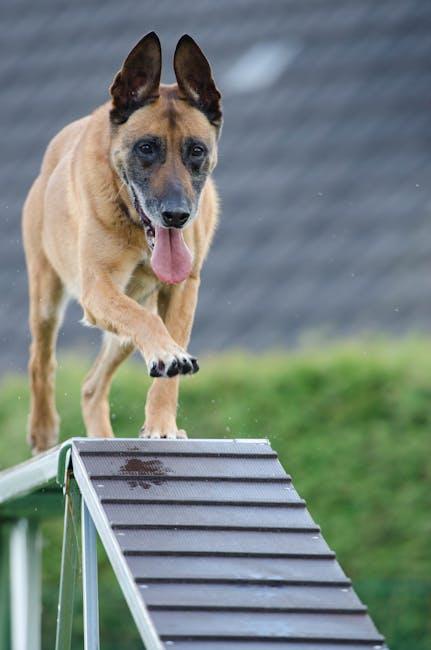In the heart of every successful dog-owner relationship lies the art of communication, a dance of mutual understanding that bridges the gap between species. At the core of this connection are verbal cues—simple words and phrases that, when used effectively, can transform the way we train and bond with our canine companions. Whether you’re a seasoned trainer or a new pet parent, understanding the power of verbal communication is essential in guiding your furry friend towards positive behaviors and a harmonious coexistence. In this article, we will explore the pivotal role that verbal cues play in dog training, offering insights and techniques to enhance your communication skills and deepen the bond with your beloved pet. Through warmth and patience, these verbal interactions become more than commands; they become a shared language that fosters trust, respect, and joy.
Understanding Your Dogs Language: The Foundation of Effective Communication
When training your dog, verbal cues play a pivotal role in bridging the gap between human and canine understanding. These cues serve as auditory signals that help your dog associate specific sounds with desired actions. Using consistent and clear verbal commands, such as “sit,” “stay,” or “come,” enhances the training process by establishing a reliable communication pathway. Here are some tips to effectively incorporate verbal cues into your training routine:
- Consistency is Key: Use the same word for each command every time. This helps your dog learn the association between the word and the action.
- Keep it Short and Simple: Opt for one-word commands to avoid confusion. Dogs respond better to concise instructions.
- Pair with Gestures: Initially, combine verbal cues with hand signals to reinforce understanding. Gradually phase out the gestures as your dog becomes more responsive to the verbal command alone.
- Positive Reinforcement: Always reward your dog with treats, praise, or affection when they successfully follow a verbal cue. This encourages them to repeat the behavior.
By mastering verbal cues, you lay the groundwork for a harmonious relationship with your furry friend, fostering trust and cooperation. Embrace patience and positivity, and watch as your communication with your dog flourishes.

Mastering Tone and Timing: How to Use Verbal Cues Successfully
In dog training, the right tone and timing can transform your verbal cues into powerful communication tools. When issuing a command, clarity and consistency are key. Dogs respond best to commands delivered in a confident, calm voice. Avoid shouting or whispering, as these extremes can confuse your furry friend. Instead, opt for a steady, firm tone that conveys assurance and expectation.
Timing is equally crucial. The moment your dog exhibits the desired behavior, follow it up with a verbal cue. This immediate reinforcement helps your dog associate the action with the word. Here are some tips to enhance your timing:
- Stay patient: Give your dog a moment to process the command.
- Be consistent: Use the same word and tone every time.
- Practice regularly: Frequent, short training sessions are more effective than sporadic, lengthy ones.
- Reward promptly: Positive reinforcement should follow the verbal cue swiftly.
By mastering the art of tone and timing, you not only improve your dog’s response to commands but also strengthen the bond between you and your canine companion.

Building Trust Through Words: Strengthening the Human-Dog Bond
Verbal cues are more than mere commands; they are the bridge that connects humans and dogs in a shared language of trust and understanding. When used effectively, these cues can transform training sessions into meaningful exchanges that strengthen the bond between you and your furry friend. Here are some ways to make the most of verbal communication:
- Consistency is Key: Always use the same words for specific actions. For instance, use “sit” for sitting, not “sit down” or “take a seat.” Consistent language helps your dog associate the word with the action more effectively.
- Positive Reinforcement: Pair your verbal cues with rewards like treats or praise. This reinforces the behavior and builds a positive connection to the words you use.
- Tone Matters: Dogs are sensitive to tone. A cheerful and encouraging voice can make a world of difference in how they respond to your cues.
- Keep it Simple: Use short, clear words or phrases. Overly complex instructions can confuse your dog and hinder training progress.
Incorporating these strategies into your training routine not only enhances communication but also deepens the mutual respect and affection that forms the heart of a strong human-dog relationship.

Practical Tips for Consistent and Clear Verbal Commands
When training your furry friend, it’s essential to use verbal commands that are both consistent and clear. Here are some practical tips to help you establish effective communication with your dog:
- Keep it simple: Use short and easy-to-pronounce words for commands. Dogs respond better to concise words like “sit,” “stay,” or ”come.” Avoid using complex phrases that may confuse them.
- Consistency is key: Stick to the same word for each command every time. If you decide on “down” for lying down, ensure all family members use the same term to avoid confusion.
- Tone matters: Your voice should be firm but friendly. A commanding tone helps convey authority, while a warm undertone reassures your dog.
- Reinforce immediately: Offer praise or a treat as soon as your dog successfully follows a command. This immediate reinforcement helps them associate the command with positive outcomes.
- Practice regularly: Regular practice sessions help reinforce learning. Short, frequent sessions are more effective than long, sporadic ones.
By following these tips, you’ll not only enhance your dog’s learning experience but also build a stronger bond with your four-legged companion. Remember, patience and positivity are your best allies in dog training.

